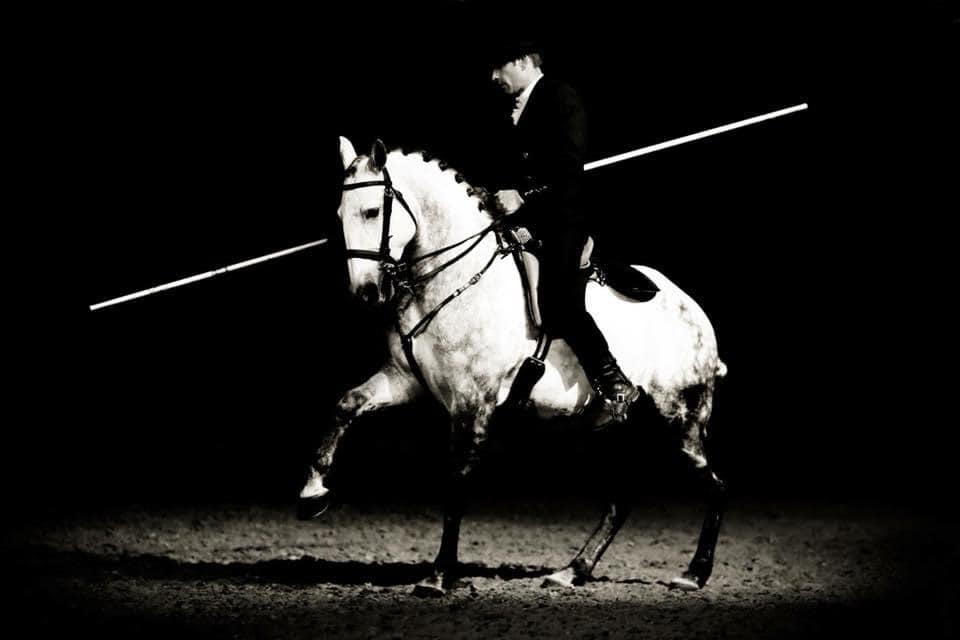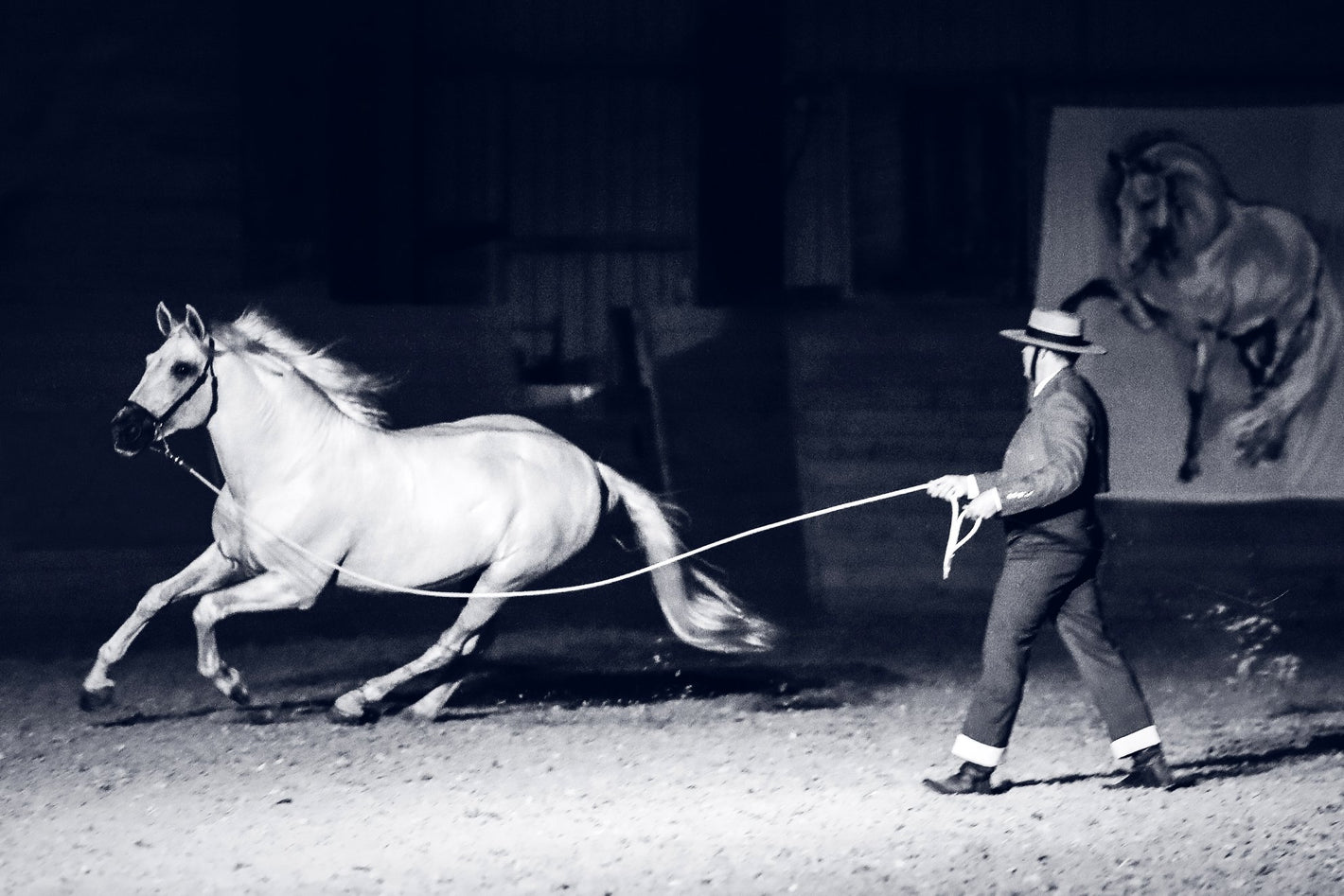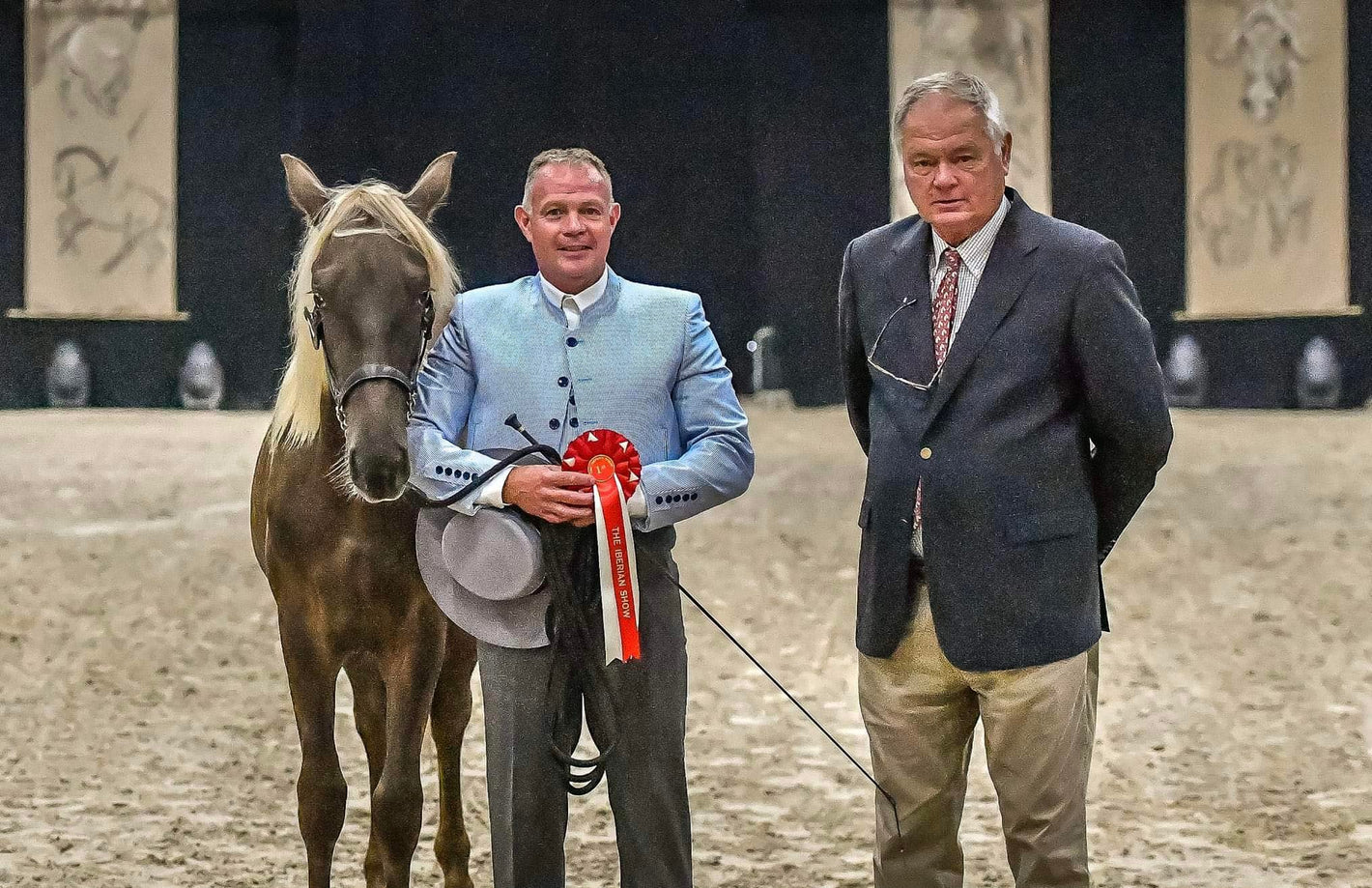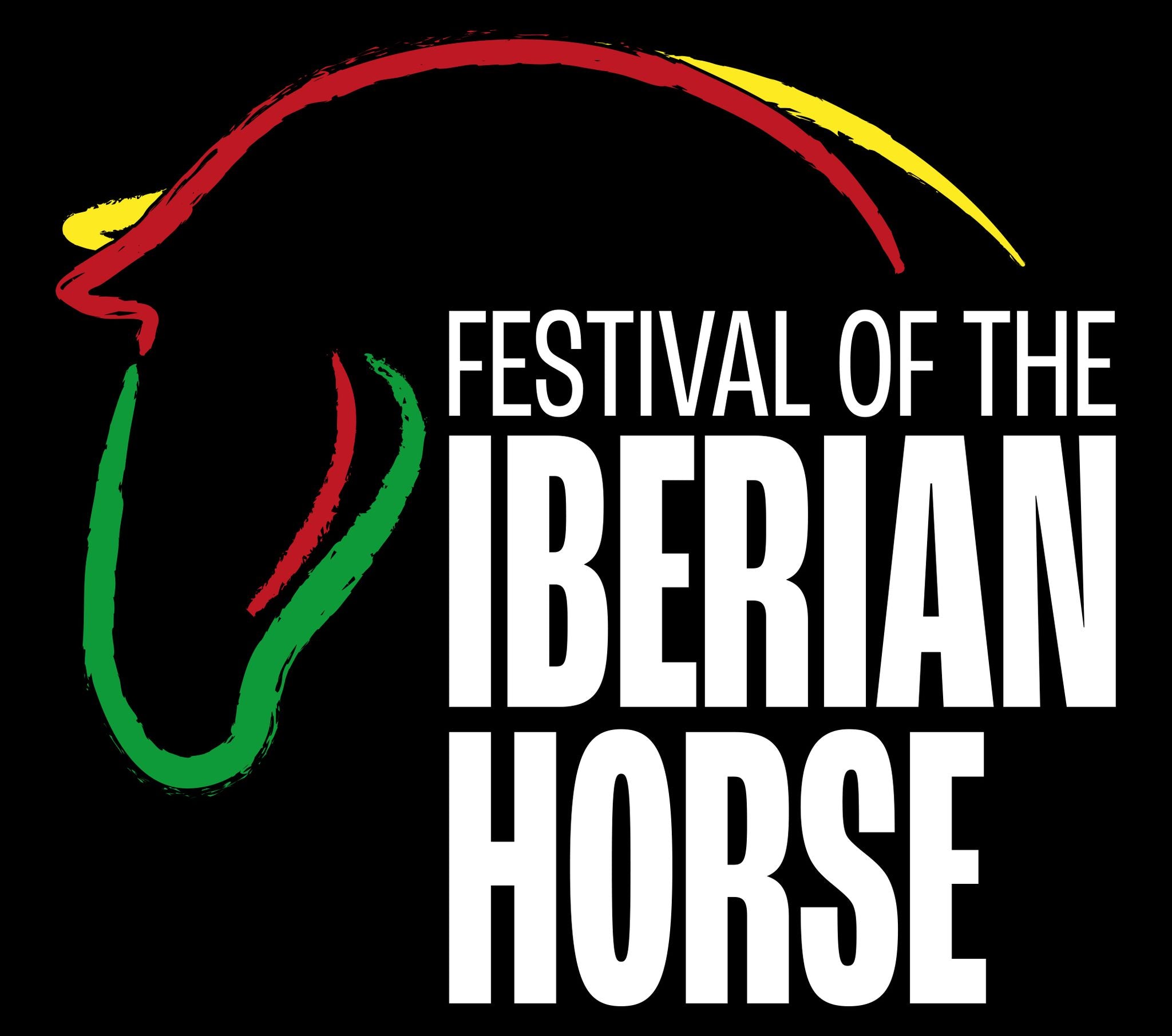THE IBERIAN HORSE
The influence and inspiration of the Iberian horse is infinite. The horses of Kings, Queens and warlords, the first choice of Hollywood Directors and mesmerising muses for artists throughout time (see La Galaria for limited edition Iberian Art). From herding cattle across the Iberian peninsula to versatile competition horses, their huge hearts and talent creates success in all spheres. The bloodlines of the horses of Spain and Portugal are as powerful as ever and can be traced back over with hundreds of years go history, the impact on other breeds all over the world is significant
There's something different about the Iberian. They form an extremely deep connection with people, their trainability and work ethic exceptional, their hearts as big as a lion, but it is more than that. The long history of war, bullfighting and as a working animal, means the bloodlines are of horses designed to be extremely brave and athletic, but with equal measures of flamboyance, exuberance and jaw dropping elegance and beauty.
Today the Iberians prove their worth as an all around sports horse, turning their hooves to all equestrian disciplines. In dressage, the domain of the warmblood, they are more and more holding their own. The Lusitano Fogoso wowed the equestrian world at the Olympics, he may be small, but he is mighty and is now in the top 50 dressage horses in the World.
The Lusitano and the PRE are the same, but also very different. They have much in common, but a great deal that sets them apart. Whilst there have always been private stud books, specific breeding programmes and passions in Spain, Portugal and then provinces within the two countries, the two breeds, were not officially split into their own stud books until the 60s. Since then, the lines have become even more distinct. The Portuguese stud book run by the APSL is renowned for being extremely strict, with many horses refused each year, a certain quality and stylisation has been heavily protected. In Spain, of course a much bigger country, with four times the horses, in the past, registrations were a little more free then in Portugal. In recent times, the breeding of pure bred Spanish horses has become far stricter under the watchful eye of ANCCE, now the governing body.
In general, but it is most certainly a generalisation, the Lusitano is a little sharper and more sensitive, in part due to the long history in Portugal of facing bulls from horseback. Whatever our personal views of bullfighting are, this history is part of their innate abilities today even though this practice is now far less widespread. Most of the studs you would buy a modern Lusitano or PRE from have no involvement with the "Corrida". There are many lines in both breeds, all with very particular characteristics and traits that each breeder has favoured over decades, so you can find very "hot" or laid back examples in both the PRE and Lusitano. Some lean more to dressage, others more to Working Equitation, some are the old very traditional and Baroque lines, some today are being bred a little taller for modern sport, this itself is a very controversial area. What we can say for sure is that the talent and traditions of these horses runs very deeply through their very veins.
Horsemanship is very much still part of modern life, classical and traditional skills and techniques have been handed down through generations. It's very common to see extremely young children riding stallions, the horses so well trained they are totally trusted taking young ones around town, or to ferias or to ride in Working Equtation and other disciplines. The skill of both the horses and riders of Spain and Portugal is absolutely central to the show we are able to bring to you.
-

The Lusitano (PSL) The Horse of Portugal
Lusitanos are extremely functional sports horses, successful in all sports but especially Working Equitation and dressage. They are now ranked 5th in the FEI dressage rankings, incxredibly impressive for such a rare breed, of only around 12,000 in the world, and with 80 breeds competing in dressage around the world.
From Professor Antonio Vicente
As one of the oldest breeds. considered by the Ancient Greeks and Romans to be the World’s best saddle horse - the very versatile Lusitano has evolved over thousands of years of selection. But it is considered an endangered breed with around 4,000 registered broodmares (half of which are in Portugal) in comparison to 40,000 PRE mares.
“Being with these horses feeds my spiritual side. From the time I first went to Portugal in 1969 and started working with Lusitanos, I have rarely had less than four of them in my stable at any time. When my late husband and I brought the first contingent back to the UK, there were 22! We just had to share them with our fellow Brits, many of whom had never heard of Lusitanos. Whether for high school level training or taking care of even the novice rider in the manege, the horses of the Iberian Penninsula always give their best and their best is beyond comparison.”
Sylvia Loch, Founder and honorary president of the Lusitano Breed Society and author of ‘The Royal Horse of Europe
From the The Lusitano Breed Society
Today the characteristics of bravery, intelligence and agility have continued to be selectively bred, broadening the appeal of the Lusitano, a horse able to turn his hoof to many disciplines. He is highly valued as a mount for classical dressage, enjoying success in the competitive arena, an athletic and talented jumper and a responsive driving horse. More traditionally he can be seen as a working horse on the plains of Portugal or the field of competitive working equitation, keeping alive the culture and tradition of the nation.www.lusitanosociety.co.uk
Featured Lusitano horse
Exparta D'Atela ridden by Paulo Santos at our 2018 show
-

The PRE - Pura Raza Española - The Horse of Spain
The Andalusian, now correctly known as the Purebred Spanish Horse or PRE (Pura Raza Española), is a horse from the Iberian Peninsula, where its ancestors have lived for thousands of years. The breed as we know it today was established in the 16th century, thanks to the efforts of King Philip II of Spain who established the basis for the modern breed, organising the breeding population in Spain and responsible for building the Royal Stables at Cordoba who are appearing at this years show. Over several decades, the breed was refined and improved until it was considered to be the perfect horse. The newly created PRE became the emblem of imperial Spain and initially was for the exclusive use of the Royal Family. Throughout its history, it has been known for its prowess as a war horse and was prized by the nobility. The breed was used as a tool of diplomacy by the Spanish government, and kings across Europe rode and owned Spanish horses. During the 19th century, warfare, disease and crossbreeding reduced herd numbers dramatically, and despite some recovery in the late 19th century, the trend continued into the early 20th century. Exports of the Spanish Horse from Spain were restricted until the 1960s, but the breed has since spread throughout the world. Today, there are well over 200,000 Purebred Spanish Horses registered worldwide.
An abundance of natural beauty, strongly built and compact yet elegant, with long, flowing thick manes and tails. They are known for their intelligence, sensitivity, docility, stamina and work ethic. The PRE is closely related to the Lusitano, and has been used to develop many other breeds. Over centuries of development, the The modern PRE is renowned for its versatility. Originally used for classical dressage, driving, bullfighting, and as stock horses, today the PRE is used for many equestrian activities, including dressage, show jumping and driving.
Featured PRE Horse
The most successful Spanish Horse at the show, Calificado stallion Penueco here is his retirement with us many years ago
-

The PRMe - The Horse of Menorca
The PRME (Pura Raza Menorquina) horses are a pure blood breed, with a long history from the Balearic Island of Menorca. Iberian of course, and with many shared characteristics, but very different to the pure blood horse of Spain the PRE (Pure Raza Espanola), these always black horses they have a very dramatic style of their own. They were given official recognition as an indigenous breed in 1989, and these very rare horses are now protected. Passionate breeders are working hard to raise their profile. In 2021, less than 4000 horses were registered.
They are famous for their appearances in the Menorcan Fiestas where they perform moves completely unique to this breed - the Elevade and Bot movements. Their own style of dressage is called “Doma Menorquina” which is ridden with the left hand only, in a very unique and traditional dress.
At the Show
The PRMes have their own dedicated classes at the show, but do not compete directly with the Lusitano or PRE horses. You'll also see them performing as a group in the evening shows - we are very happy to make a contribtion in promoting this wonderful and fascinating breed.
Featured horses
Four youngsters from the Forbes Stock stud run by Chris Johns here in the UK
-

The PRE Fusion
Founded in 1982, under the title of Register II PRE Part bred Studbook, the PRE Fusion Studbook was opened to cater for British Breeders who wished to capture the exceptionally excellent qualities and characteristics of the extremely rare Purebred Spanish Horse (PRE) in their breeding programmes whilst adding attributes from other breeds that would make the resulting horses more suitable to the demands of British riders and competitors. This has resulted in a very adaptable breed which is able to stay popular because breeders are able to adjust the balance of attributes in the PRE Fusion Horses in order to keep up with the ever changing market pressures of the equine industry and hobby. The PRE Fusion Horse Studbook now features many 4th, 5th and 6th generation PRE Fusion horses that excel in a wide range of highly competitive sports, the result of many years of dedicated breeding within the UK. There are many different classifications of PRE Fusions - see the GBPRE website to find out more. You will see a number of fusions competing at the show with some additional prizes for them being awarded by BAPSH - the organisation that runs the Spanish stud book here in the UK
Featured PRE Fusion horse
Mistrals Silver Knight owned by Janine Falle, presented by Paul Bettens at last years show




